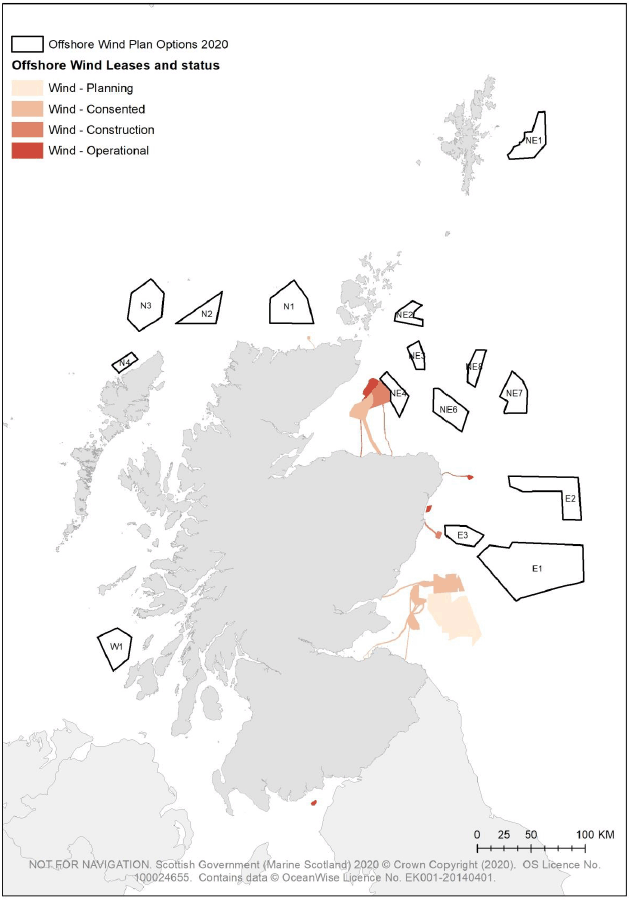Sectoral marine plan for offshore wind energy
Aims to identify sustainable plan options for the future development of commercial-scale offshore wind energy in Scotland, including deep water wind technologies, and covers both Scottish inshore and offshore waters.
1. Introduction and background
The Scottish Government is committed to ensuring secure, reliable and affordable energy supplies, within the context of long-term decarbonisation of energy generation. As set out in the Offshore Wind Policy Statement,[1] which builds on the ambitions outlined in Scotland's Energy Strategy,[2] the continued growth of the renewable energy sector in Scotland will be an essential feature of our future clean energy system and a potential key driver of economic growth. As a nation with an abundance of renewable energy resources, opportunities exist not only to meet domestic needs, but also to export low carbon energy to the rest of UK and Europe.
To-date, Scotland has seen a significant amount of offshore wind energy activity, with 14 offshore wind farms (including two floating wind farms) having received consent, six of which are currently operational. This equates to a total generating capacity of just over 5 Gigawatts ("GW"). Our first Sectoral Marine Plan for Offshore Wind Energy (Blue Seas Green Energy) ("the 2011 Plan") was adopted in 2011,[3] with draft wind, wave and tidal plans subsequently produced in 2013.[4]
Three of the six short-term option sites identified in the 2011 Plan have progressed to consenting (Beatrice, Inch Cape and Neart na Gaoithe), with Beatrice Offshore Wind Farm becoming operational in 2019 with an installed capacity of 588 MW. As part of the 3rd UK Offshore Wind Farm Leasing Round, two Round 3 sites are being progressed in Scottish Waters - the Firth of Forth Offshore Wind Zone and the Moray Firth Offshore Wind Zone.
Recent technological, policy, regulatory and market developments, such as the commitments outlined in the UK Offshore Wind Sector Deal,[5] the development of new technologies suitable for deployment in deeper water and the aspirations established in recent climate change legislation presented the opportunity for Scottish Ministers to undertake a new strategic planning process to support further offshore wind development in Scotland's seas. This planning process provides the spatial strategy to support the current CES ScotWind leasing round, the first offshore wind leasing round to be administered in Scotland.

Offshore wind energy has the potential to play a pivotal role in Scotland's energy system over the coming decades. As the amount of planned and constructed offshore wind development increases, however, opportunities to install offshore windfarms close to shore and/or in shallower waters will decrease, resulting in the need to explore opportunities to develop sites located further offshore and/or in deeper waters. These types of development pose new technical and financial constraints which will need to be overcome. However, Scotland has natural advantages in terms of a combination of high wind speeds and availability of deep water sites, which help to address these challenges. The development of deep water wind technology also provides an opportunity to further develop offshore wind supply chains and to lever existing infrastructure and supply chain capabilities from the offshore oil and gas industry and help create the requisite conditions to position Scotland as a world leader in deep water wind technologies. This Plan provides opportunities for development within deeper waters, a consideration not factored into the 2011 Plan.
The Plan development process has taken into account wider policies and priorities relating to climate change, lowering carbon emissions and promoting green energy to ensure that the Plan supports the delivery of our national and international obligations. The process has also taken into consideration the potential economic, social and environmental impacts of offshore wind energy and has been undertaken in accordance with relevant Scottish, UK and EU legislation.
During April 2019, the First Minister declared a global climate emergency, making Scotland one of the first countries in the world to do so. Following this, the Scottish Government has set a net-zero greenhouse gas emissions target for 2045, with interim targets of 75% by 2030 and 90% by 2040, thereby putting in place the most stringent framework of statutory targets globally.
The COVID-19 pandemic has seen unprecedented changes in our society, necessitating the need to review our commitments and programmes to achieve our transition to a net-zero society and support Scotland's economic recovery in a manner consistent with these aims. The Cabinet Sectary for Environment, Climate Change and Land Reform announced that she hoped to lay a revised Climate Change Plan[6] ("CCP") before the end of 2020 and the recast plan will set out a pathway as part of the work towards a green economic recovery. Furthermore, the Programme for Government commits to delivering a Blue Economy Action Plan, to strengthen the resilience of our marine industries and support coastal communities. This Plan, enabling strategic offshore wind development in Scotland, is a key driver in building our Blue Economy, helping to maximise sustainable development in Scotland.
The Plan will provide the strategic framework for the first cycle of seabed leasing for commercial-scale offshore wind by Crown Estate Scotland (the 'ScotWind' leasing round). This Plan provides the strategically planned spatial footprint for offshore wind development in Scotland and - alongside the Offshore Wind Policy Statement ("OWPS"), CCP review and the Economic Recovery Implementation Plan [7] - forms part of the framework to ensure our sustainable green recovery.
Contact
There is a problem
Thanks for your feedback